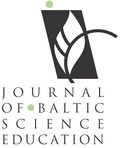USING COMICS FOR CLIMATE CHANGE IN SCIENCE EDUCATION: STUDENTS' SOLUTIONS AND AESTHETIC SUBTLETIES
| Title | USING COMICS FOR CLIMATE CHANGE IN SCIENCE EDUCATION: STUDENTS' SOLUTIONS AND AESTHETIC SUBTLETIES |
| Publication Type | Journal Article |
| Year of Publication | 2023 |
| Authors | Alp, G, Coskun Onan, B. |
| Journal | Journal of Baltic Science Education |
| Volume | 22 |
| Issue | 2 |
| Start Page | 215-231 |
| Pagination | Continuous |
| Date Published | April/2023 |
| Type of Article | Original article |
| ISSN | 1648-3898 |
| Other Numbers | E-ISSN 2538-7138 |
| Keywords | case study, digital comics, digital story, digital storytelling, secondary school students |
| Abstract | To constitute awareness of climate change, hearing the solutions of students in their words and seeing visual products by creating experiences in schools is vital. This case study was limited to sequential implementations of climate change in the natural sciences teaching process in 5th grade. After an education process on using Pixton, 12 students transformed their learning into digital comics. This research aimed to reveal the problems created by students through digital stories about climate change, solutions they suggested for climate problems, and aesthetic subtleties they applied to express themselves. Digital comics created by students, researcher notes, observations, and students’ view forms were used as data collection tools. Finally, vital solutions to problems such as global climate change, pollution, destruction of the natural environment, and extinction of living creatures were created by students during this case. Important solutions consisting of preventing global warming, making peace with nature, vital measures and efforts to protect the soil were suggested. Besides, interesting aesthetic subtleties such as storification, positioning of the characters, place preferences, expression of emotions, and time depiction were applied. Teachers can use comics to see students’ tendencies, raise awareness, encourage them, and help them develop solutions for current socio-scientific problems. |
| URL | https://oaji.net/articles/2023/987-1681286476.pdf |
| DOI | 10.33225/jbse/23.22.215 |
| Refereed Designation | Refereed |
| Full Text |
